Comparative Analysis of OSPF and iBGP Routing Protocols and Design
VerifiedAdded on 2023/01/23
|8
|2106
|49
Report
AI Summary
This report compares and contrasts the OSPF (Open Shortest Path First) and iBGP (internal Border Gateway Protocol) routing protocols. It details the differences in their operational mechanisms, including link-state routing for OSPF versus path vector routing for iBGP, and their application domains (intra-domain vs. inter-domain). The report highlights the differences in convergence time, resource usage (CPU and memory), and implementation complexity. It explores OSPF and iBGP's supportive design using OPNET software, presenting simulations of network convergence and traffic patterns. The report concludes by emphasizing OSPF's suitability for scenarios requiring rapid response and iBGP's relevance in resource-constrained systems. The provided references include various research papers and articles supporting the analysis.

Student Name
Professor’s Name
Affiliation
Date
Professor’s Name
Affiliation
Date
Paraphrase This Document
Need a fresh take? Get an instant paraphrase of this document with our AI Paraphraser
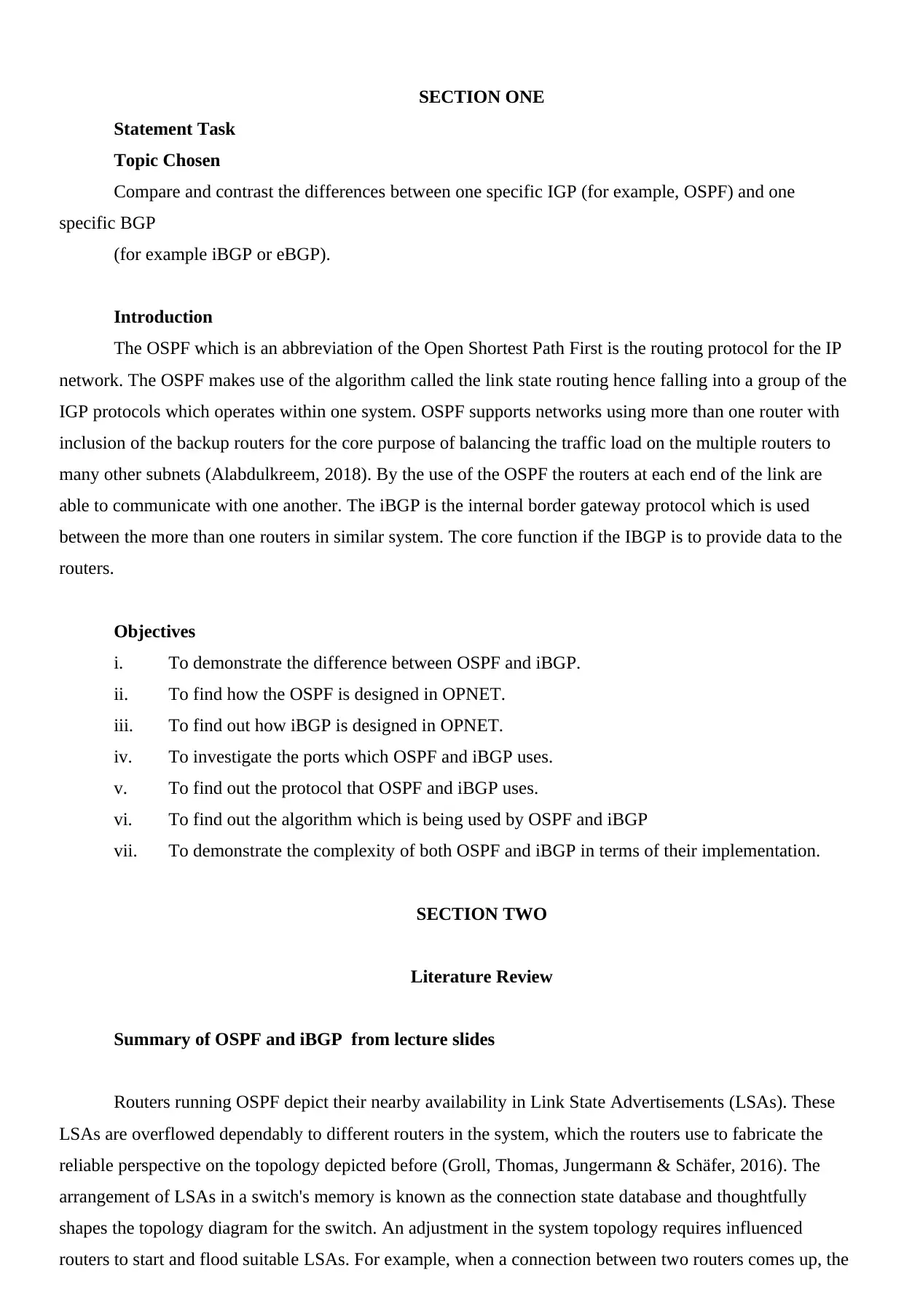
SECTION ONE
Statement Task
Topic Chosen
Compare and contrast the differences between one specific IGP (for example, OSPF) and one
specific BGP
(for example iBGP or eBGP).
Introduction
The OSPF which is an abbreviation of the Open Shortest Path First is the routing protocol for the IP
network. The OSPF makes use of the algorithm called the link state routing hence falling into a group of the
IGP protocols which operates within one system. OSPF supports networks using more than one router with
inclusion of the backup routers for the core purpose of balancing the traffic load on the multiple routers to
many other subnets (Alabdulkreem, 2018). By the use of the OSPF the routers at each end of the link are
able to communicate with one another. The iBGP is the internal border gateway protocol which is used
between the more than one routers in similar system. The core function if the IBGP is to provide data to the
routers.
Objectives
i. To demonstrate the difference between OSPF and iBGP.
ii. To find how the OSPF is designed in OPNET.
iii. To find out how iBGP is designed in OPNET.
iv. To investigate the ports which OSPF and iBGP uses.
v. To find out the protocol that OSPF and iBGP uses.
vi. To find out the algorithm which is being used by OSPF and iBGP
vii. To demonstrate the complexity of both OSPF and iBGP in terms of their implementation.
SECTION TWO
Literature Review
Summary of OSPF and iBGP from lecture slides
Routers running OSPF depict their nearby availability in Link State Advertisements (LSAs). These
LSAs are overflowed dependably to different routers in the system, which the routers use to fabricate the
reliable perspective on the topology depicted before (Groll, Thomas, Jungermann & Schäfer, 2016). The
arrangement of LSAs in a switch's memory is known as the connection state database and thoughtfully
shapes the topology diagram for the switch. An adjustment in the system topology requires influenced
routers to start and flood suitable LSAs. For example, when a connection between two routers comes up, the
Statement Task
Topic Chosen
Compare and contrast the differences between one specific IGP (for example, OSPF) and one
specific BGP
(for example iBGP or eBGP).
Introduction
The OSPF which is an abbreviation of the Open Shortest Path First is the routing protocol for the IP
network. The OSPF makes use of the algorithm called the link state routing hence falling into a group of the
IGP protocols which operates within one system. OSPF supports networks using more than one router with
inclusion of the backup routers for the core purpose of balancing the traffic load on the multiple routers to
many other subnets (Alabdulkreem, 2018). By the use of the OSPF the routers at each end of the link are
able to communicate with one another. The iBGP is the internal border gateway protocol which is used
between the more than one routers in similar system. The core function if the IBGP is to provide data to the
routers.
Objectives
i. To demonstrate the difference between OSPF and iBGP.
ii. To find how the OSPF is designed in OPNET.
iii. To find out how iBGP is designed in OPNET.
iv. To investigate the ports which OSPF and iBGP uses.
v. To find out the protocol that OSPF and iBGP uses.
vi. To find out the algorithm which is being used by OSPF and iBGP
vii. To demonstrate the complexity of both OSPF and iBGP in terms of their implementation.
SECTION TWO
Literature Review
Summary of OSPF and iBGP from lecture slides
Routers running OSPF depict their nearby availability in Link State Advertisements (LSAs). These
LSAs are overflowed dependably to different routers in the system, which the routers use to fabricate the
reliable perspective on the topology depicted before (Groll, Thomas, Jungermann & Schäfer, 2016). The
arrangement of LSAs in a switch's memory is known as the connection state database and thoughtfully
shapes the topology diagram for the switch. An adjustment in the system topology requires influenced
routers to start and flood suitable LSAs. For example, when a connection between two routers comes up, the
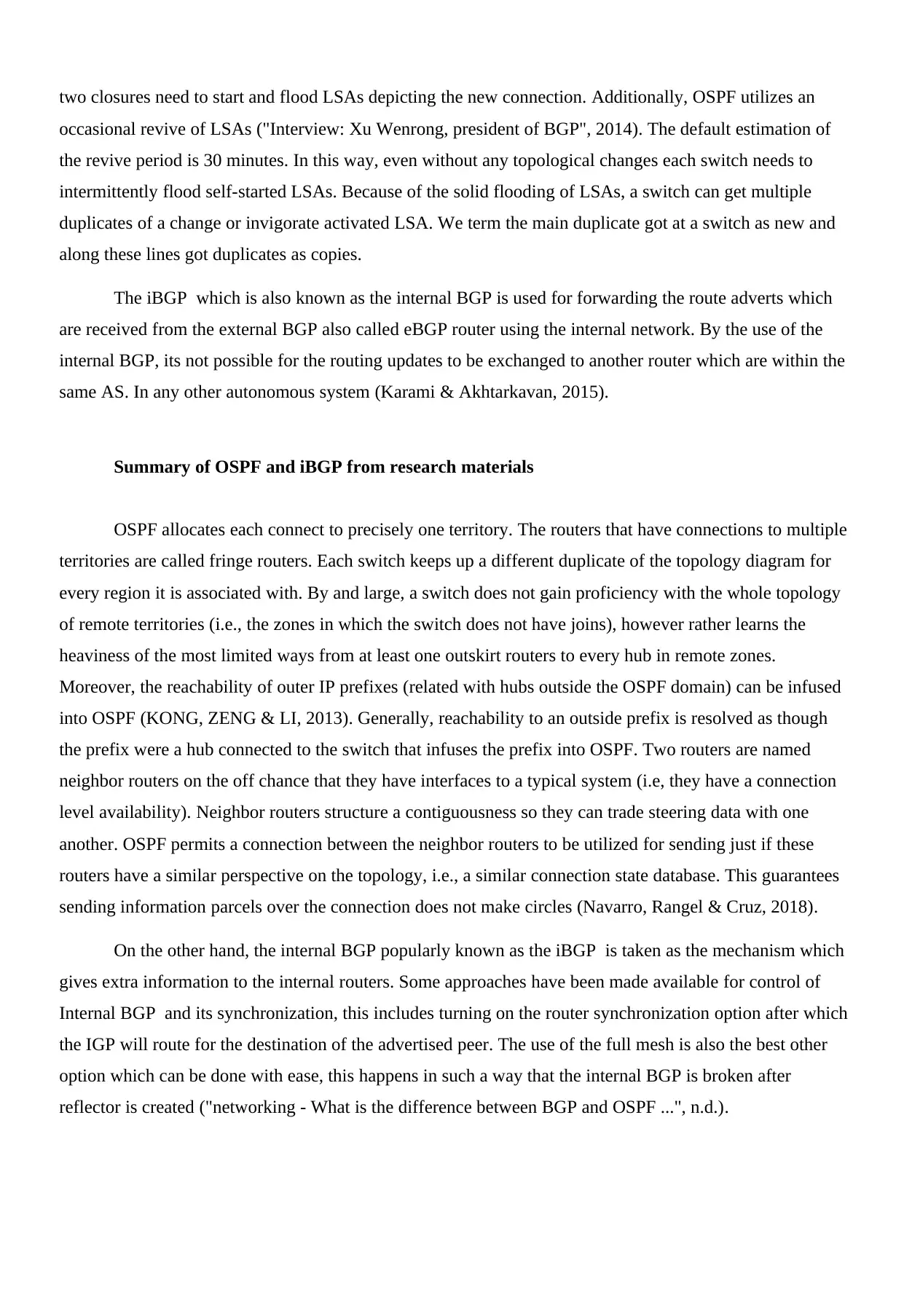
two closures need to start and flood LSAs depicting the new connection. Additionally, OSPF utilizes an
occasional revive of LSAs ("Interview: Xu Wenrong, president of BGP", 2014). The default estimation of
the revive period is 30 minutes. In this way, even without any topological changes each switch needs to
intermittently flood self-started LSAs. Because of the solid flooding of LSAs, a switch can get multiple
duplicates of a change or invigorate activated LSA. We term the main duplicate got at a switch as new and
along these lines got duplicates as copies.
The iBGP which is also known as the internal BGP is used for forwarding the route adverts which
are received from the external BGP also called eBGP router using the internal network. By the use of the
internal BGP, its not possible for the routing updates to be exchanged to another router which are within the
same AS. In any other autonomous system (Karami & Akhtarkavan, 2015).
Summary of OSPF and iBGP from research materials
OSPF allocates each connect to precisely one territory. The routers that have connections to multiple
territories are called fringe routers. Each switch keeps up a different duplicate of the topology diagram for
every region it is associated with. By and large, a switch does not gain proficiency with the whole topology
of remote territories (i.e., the zones in which the switch does not have joins), however rather learns the
heaviness of the most limited ways from at least one outskirt routers to every hub in remote zones.
Moreover, the reachability of outer IP prefixes (related with hubs outside the OSPF domain) can be infused
into OSPF (KONG, ZENG & LI, 2013). Generally, reachability to an outside prefix is resolved as though
the prefix were a hub connected to the switch that infuses the prefix into OSPF. Two routers are named
neighbor routers on the off chance that they have interfaces to a typical system (i.e, they have a connection
level availability). Neighbor routers structure a contiguousness so they can trade steering data with one
another. OSPF permits a connection between the neighbor routers to be utilized for sending just if these
routers have a similar perspective on the topology, i.e., a similar connection state database. This guarantees
sending information parcels over the connection does not make circles (Navarro, Rangel & Cruz, 2018).
On the other hand, the internal BGP popularly known as the iBGP is taken as the mechanism which
gives extra information to the internal routers. Some approaches have been made available for control of
Internal BGP and its synchronization, this includes turning on the router synchronization option after which
the IGP will route for the destination of the advertised peer. The use of the full mesh is also the best other
option which can be done with ease, this happens in such a way that the internal BGP is broken after
reflector is created ("networking - What is the difference between BGP and OSPF ...", n.d.).
occasional revive of LSAs ("Interview: Xu Wenrong, president of BGP", 2014). The default estimation of
the revive period is 30 minutes. In this way, even without any topological changes each switch needs to
intermittently flood self-started LSAs. Because of the solid flooding of LSAs, a switch can get multiple
duplicates of a change or invigorate activated LSA. We term the main duplicate got at a switch as new and
along these lines got duplicates as copies.
The iBGP which is also known as the internal BGP is used for forwarding the route adverts which
are received from the external BGP also called eBGP router using the internal network. By the use of the
internal BGP, its not possible for the routing updates to be exchanged to another router which are within the
same AS. In any other autonomous system (Karami & Akhtarkavan, 2015).
Summary of OSPF and iBGP from research materials
OSPF allocates each connect to precisely one territory. The routers that have connections to multiple
territories are called fringe routers. Each switch keeps up a different duplicate of the topology diagram for
every region it is associated with. By and large, a switch does not gain proficiency with the whole topology
of remote territories (i.e., the zones in which the switch does not have joins), however rather learns the
heaviness of the most limited ways from at least one outskirt routers to every hub in remote zones.
Moreover, the reachability of outer IP prefixes (related with hubs outside the OSPF domain) can be infused
into OSPF (KONG, ZENG & LI, 2013). Generally, reachability to an outside prefix is resolved as though
the prefix were a hub connected to the switch that infuses the prefix into OSPF. Two routers are named
neighbor routers on the off chance that they have interfaces to a typical system (i.e, they have a connection
level availability). Neighbor routers structure a contiguousness so they can trade steering data with one
another. OSPF permits a connection between the neighbor routers to be utilized for sending just if these
routers have a similar perspective on the topology, i.e., a similar connection state database. This guarantees
sending information parcels over the connection does not make circles (Navarro, Rangel & Cruz, 2018).
On the other hand, the internal BGP popularly known as the iBGP is taken as the mechanism which
gives extra information to the internal routers. Some approaches have been made available for control of
Internal BGP and its synchronization, this includes turning on the router synchronization option after which
the IGP will route for the destination of the advertised peer. The use of the full mesh is also the best other
option which can be done with ease, this happens in such a way that the internal BGP is broken after
reflector is created ("networking - What is the difference between BGP and OSPF ...", n.d.).
⊘ This is a preview!⊘
Do you want full access?
Subscribe today to unlock all pages.

Trusted by 1+ million students worldwide
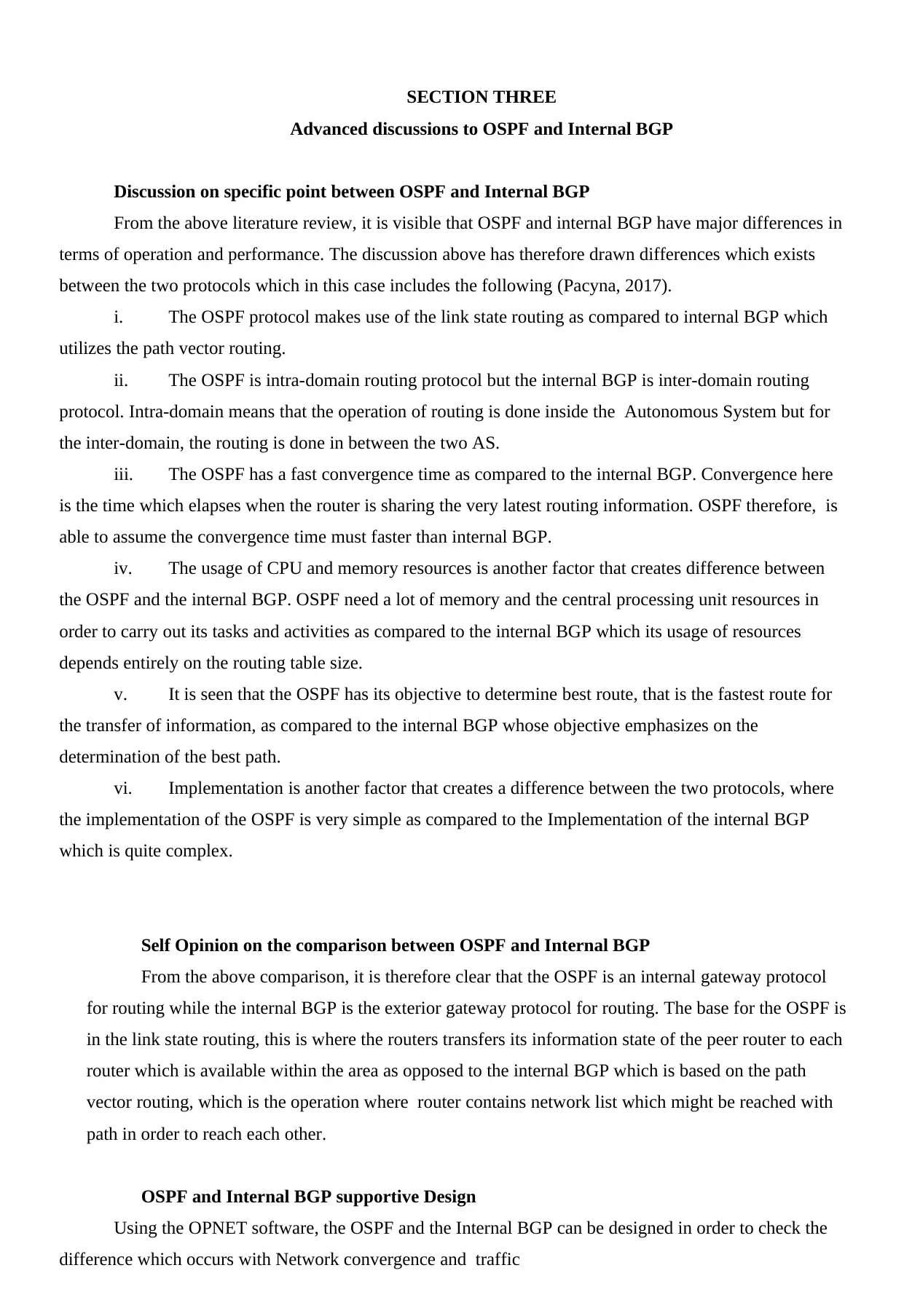
SECTION THREE
Advanced discussions to OSPF and Internal BGP
Discussion on specific point between OSPF and Internal BGP
From the above literature review, it is visible that OSPF and internal BGP have major differences in
terms of operation and performance. The discussion above has therefore drawn differences which exists
between the two protocols which in this case includes the following (Pacyna, 2017).
i. The OSPF protocol makes use of the link state routing as compared to internal BGP which
utilizes the path vector routing.
ii. The OSPF is intra-domain routing protocol but the internal BGP is inter-domain routing
protocol. Intra-domain means that the operation of routing is done inside the Autonomous System but for
the inter-domain, the routing is done in between the two AS.
iii. The OSPF has a fast convergence time as compared to the internal BGP. Convergence here
is the time which elapses when the router is sharing the very latest routing information. OSPF therefore, is
able to assume the convergence time must faster than internal BGP.
iv. The usage of CPU and memory resources is another factor that creates difference between
the OSPF and the internal BGP. OSPF need a lot of memory and the central processing unit resources in
order to carry out its tasks and activities as compared to the internal BGP which its usage of resources
depends entirely on the routing table size.
v. It is seen that the OSPF has its objective to determine best route, that is the fastest route for
the transfer of information, as compared to the internal BGP whose objective emphasizes on the
determination of the best path.
vi. Implementation is another factor that creates a difference between the two protocols, where
the implementation of the OSPF is very simple as compared to the Implementation of the internal BGP
which is quite complex.
Self Opinion on the comparison between OSPF and Internal BGP
From the above comparison, it is therefore clear that the OSPF is an internal gateway protocol
for routing while the internal BGP is the exterior gateway protocol for routing. The base for the OSPF is
in the link state routing, this is where the routers transfers its information state of the peer router to each
router which is available within the area as opposed to the internal BGP which is based on the path
vector routing, which is the operation where router contains network list which might be reached with
path in order to reach each other.
OSPF and Internal BGP supportive Design
Using the OPNET software, the OSPF and the Internal BGP can be designed in order to check the
difference which occurs with Network convergence and traffic
Advanced discussions to OSPF and Internal BGP
Discussion on specific point between OSPF and Internal BGP
From the above literature review, it is visible that OSPF and internal BGP have major differences in
terms of operation and performance. The discussion above has therefore drawn differences which exists
between the two protocols which in this case includes the following (Pacyna, 2017).
i. The OSPF protocol makes use of the link state routing as compared to internal BGP which
utilizes the path vector routing.
ii. The OSPF is intra-domain routing protocol but the internal BGP is inter-domain routing
protocol. Intra-domain means that the operation of routing is done inside the Autonomous System but for
the inter-domain, the routing is done in between the two AS.
iii. The OSPF has a fast convergence time as compared to the internal BGP. Convergence here
is the time which elapses when the router is sharing the very latest routing information. OSPF therefore, is
able to assume the convergence time must faster than internal BGP.
iv. The usage of CPU and memory resources is another factor that creates difference between
the OSPF and the internal BGP. OSPF need a lot of memory and the central processing unit resources in
order to carry out its tasks and activities as compared to the internal BGP which its usage of resources
depends entirely on the routing table size.
v. It is seen that the OSPF has its objective to determine best route, that is the fastest route for
the transfer of information, as compared to the internal BGP whose objective emphasizes on the
determination of the best path.
vi. Implementation is another factor that creates a difference between the two protocols, where
the implementation of the OSPF is very simple as compared to the Implementation of the internal BGP
which is quite complex.
Self Opinion on the comparison between OSPF and Internal BGP
From the above comparison, it is therefore clear that the OSPF is an internal gateway protocol
for routing while the internal BGP is the exterior gateway protocol for routing. The base for the OSPF is
in the link state routing, this is where the routers transfers its information state of the peer router to each
router which is available within the area as opposed to the internal BGP which is based on the path
vector routing, which is the operation where router contains network list which might be reached with
path in order to reach each other.
OSPF and Internal BGP supportive Design
Using the OPNET software, the OSPF and the Internal BGP can be designed in order to check the
difference which occurs with Network convergence and traffic
Paraphrase This Document
Need a fresh take? Get an instant paraphrase of this document with our AI Paraphraser
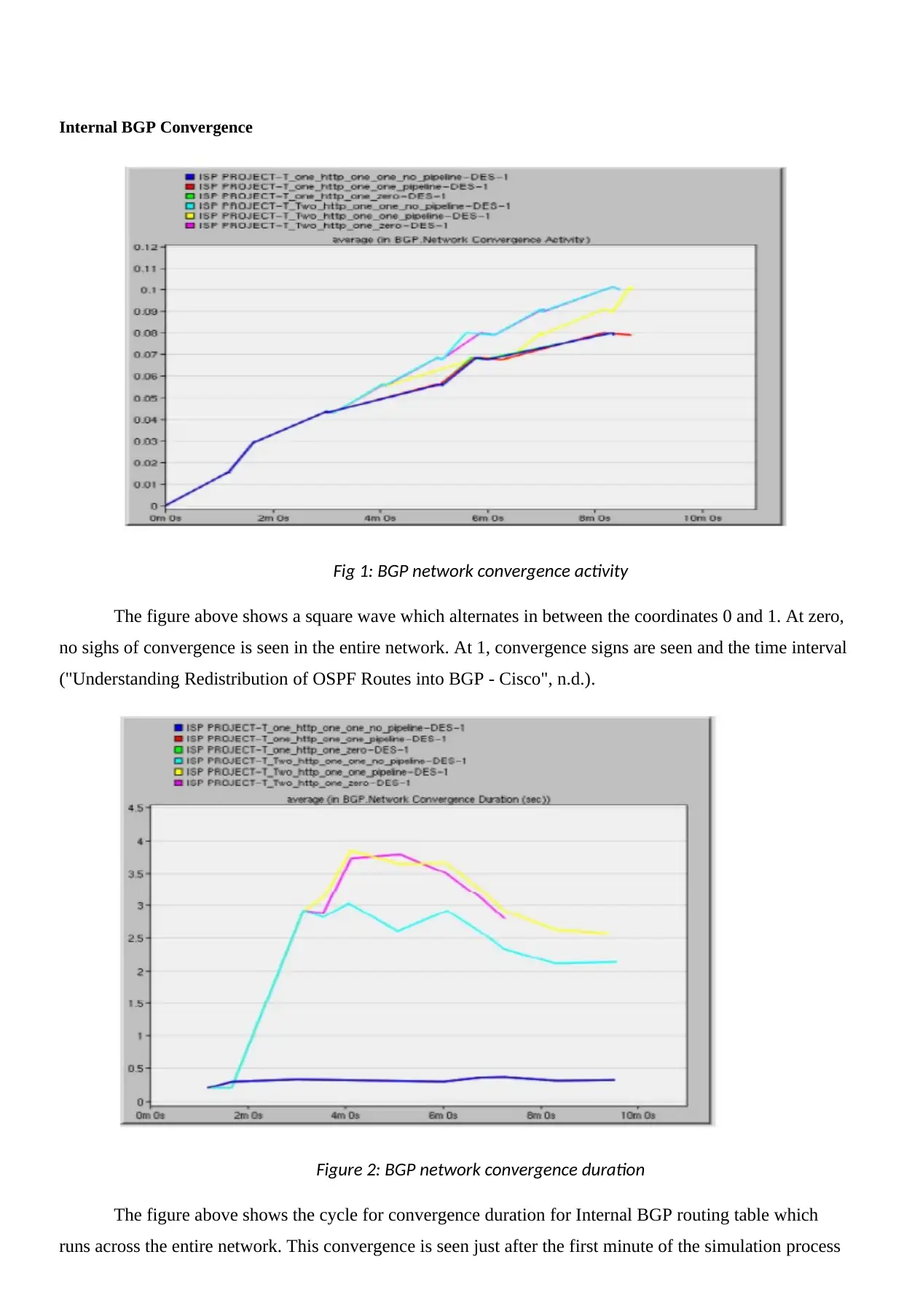
Internal BGP Convergence
Fig 1: BGP network convergence activity
The figure above shows a square wave which alternates in between the coordinates 0 and 1. At zero,
no sighs of convergence is seen in the entire network. At 1, convergence signs are seen and the time interval
("Understanding Redistribution of OSPF Routes into BGP - Cisco", n.d.).
Figure 2: BGP network convergence duration
The figure above shows the cycle for convergence duration for Internal BGP routing table which
runs across the entire network. This convergence is seen just after the first minute of the simulation process
Fig 1: BGP network convergence activity
The figure above shows a square wave which alternates in between the coordinates 0 and 1. At zero,
no sighs of convergence is seen in the entire network. At 1, convergence signs are seen and the time interval
("Understanding Redistribution of OSPF Routes into BGP - Cisco", n.d.).
Figure 2: BGP network convergence duration
The figure above shows the cycle for convergence duration for Internal BGP routing table which
runs across the entire network. This convergence is seen just after the first minute of the simulation process
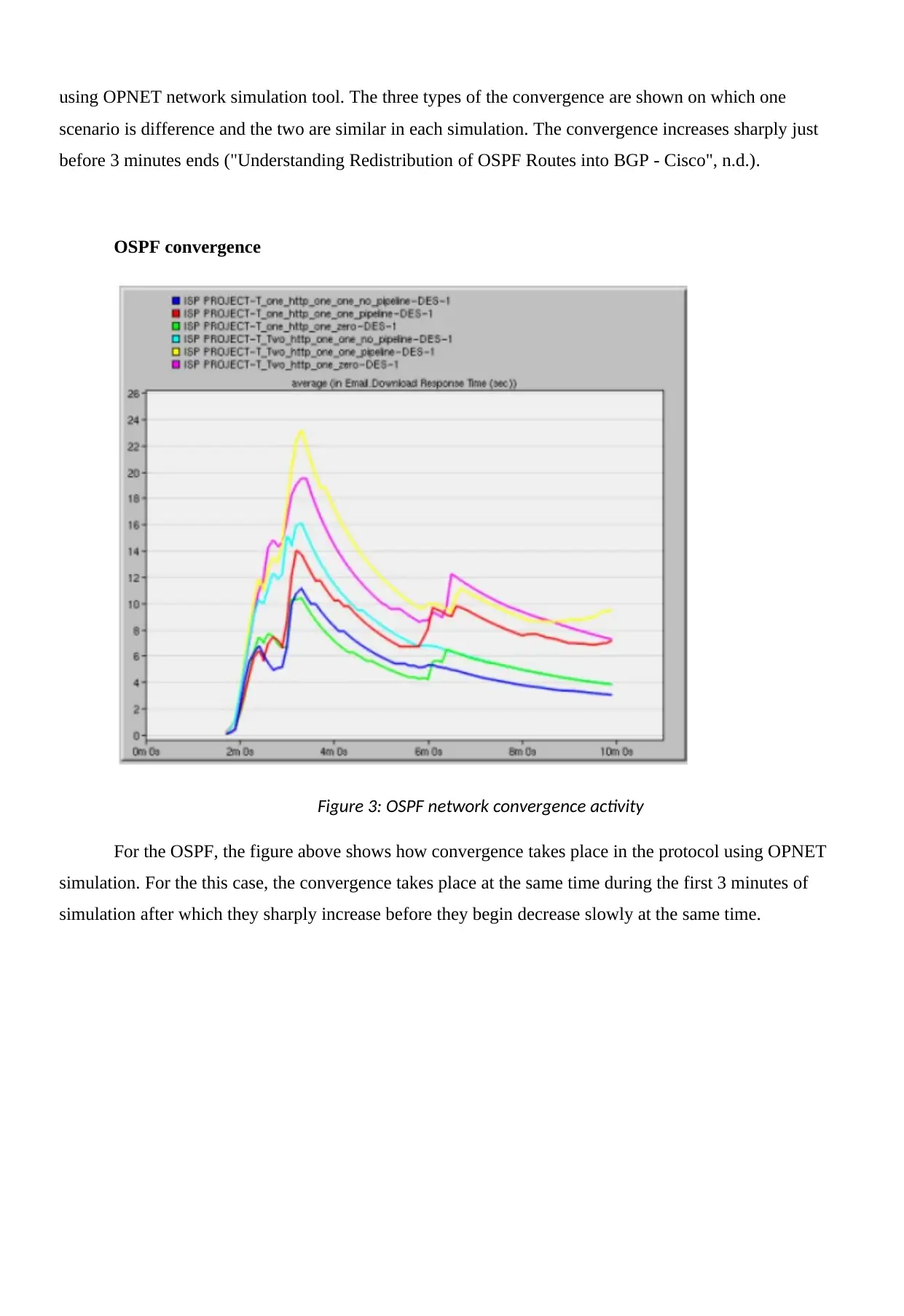
using OPNET network simulation tool. The three types of the convergence are shown on which one
scenario is difference and the two are similar in each simulation. The convergence increases sharply just
before 3 minutes ends ("Understanding Redistribution of OSPF Routes into BGP - Cisco", n.d.).
OSPF convergence
Figure 3: OSPF network convergence activity
For the OSPF, the figure above shows how convergence takes place in the protocol using OPNET
simulation. For the this case, the convergence takes place at the same time during the first 3 minutes of
simulation after which they sharply increase before they begin decrease slowly at the same time.
scenario is difference and the two are similar in each simulation. The convergence increases sharply just
before 3 minutes ends ("Understanding Redistribution of OSPF Routes into BGP - Cisco", n.d.).
OSPF convergence
Figure 3: OSPF network convergence activity
For the OSPF, the figure above shows how convergence takes place in the protocol using OPNET
simulation. For the this case, the convergence takes place at the same time during the first 3 minutes of
simulation after which they sharply increase before they begin decrease slowly at the same time.
⊘ This is a preview!⊘
Do you want full access?
Subscribe today to unlock all pages.

Trusted by 1+ million students worldwide
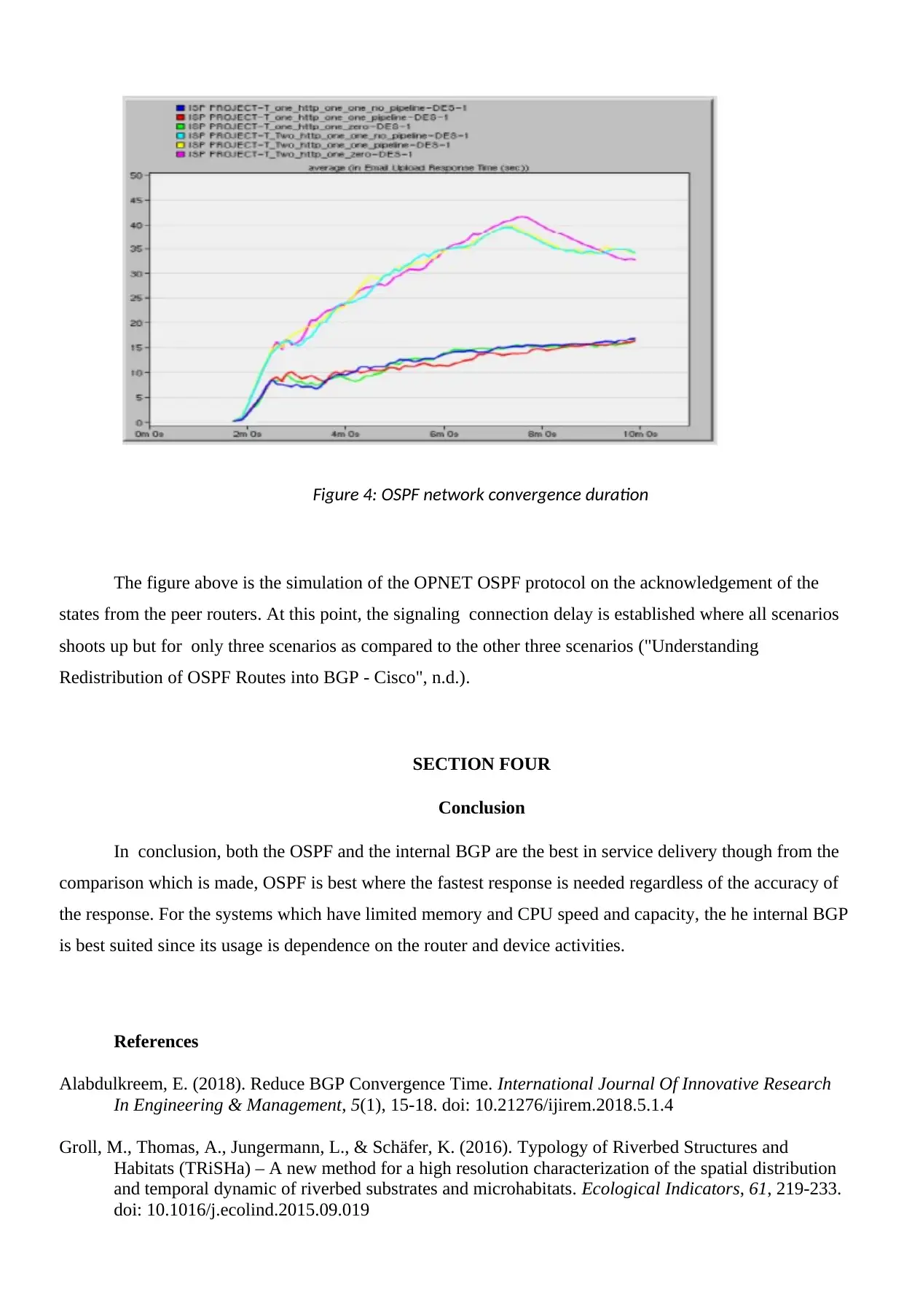
Figure 4: OSPF network convergence duration
The figure above is the simulation of the OPNET OSPF protocol on the acknowledgement of the
states from the peer routers. At this point, the signaling connection delay is established where all scenarios
shoots up but for only three scenarios as compared to the other three scenarios ("Understanding
Redistribution of OSPF Routes into BGP - Cisco", n.d.).
SECTION FOUR
Conclusion
In conclusion, both the OSPF and the internal BGP are the best in service delivery though from the
comparison which is made, OSPF is best where the fastest response is needed regardless of the accuracy of
the response. For the systems which have limited memory and CPU speed and capacity, the he internal BGP
is best suited since its usage is dependence on the router and device activities.
References
Alabdulkreem, E. (2018). Reduce BGP Convergence Time. International Journal Of Innovative Research
In Engineering & Management, 5(1), 15-18. doi: 10.21276/ijirem.2018.5.1.4
Groll, M., Thomas, A., Jungermann, L., & Schäfer, K. (2016). Typology of Riverbed Structures and
Habitats (TRiSHa) – A new method for a high resolution characterization of the spatial distribution
and temporal dynamic of riverbed substrates and microhabitats. Ecological Indicators, 61, 219-233.
doi: 10.1016/j.ecolind.2015.09.019
The figure above is the simulation of the OPNET OSPF protocol on the acknowledgement of the
states from the peer routers. At this point, the signaling connection delay is established where all scenarios
shoots up but for only three scenarios as compared to the other three scenarios ("Understanding
Redistribution of OSPF Routes into BGP - Cisco", n.d.).
SECTION FOUR
Conclusion
In conclusion, both the OSPF and the internal BGP are the best in service delivery though from the
comparison which is made, OSPF is best where the fastest response is needed regardless of the accuracy of
the response. For the systems which have limited memory and CPU speed and capacity, the he internal BGP
is best suited since its usage is dependence on the router and device activities.
References
Alabdulkreem, E. (2018). Reduce BGP Convergence Time. International Journal Of Innovative Research
In Engineering & Management, 5(1), 15-18. doi: 10.21276/ijirem.2018.5.1.4
Groll, M., Thomas, A., Jungermann, L., & Schäfer, K. (2016). Typology of Riverbed Structures and
Habitats (TRiSHa) – A new method for a high resolution characterization of the spatial distribution
and temporal dynamic of riverbed substrates and microhabitats. Ecological Indicators, 61, 219-233.
doi: 10.1016/j.ecolind.2015.09.019
Paraphrase This Document
Need a fresh take? Get an instant paraphrase of this document with our AI Paraphraser
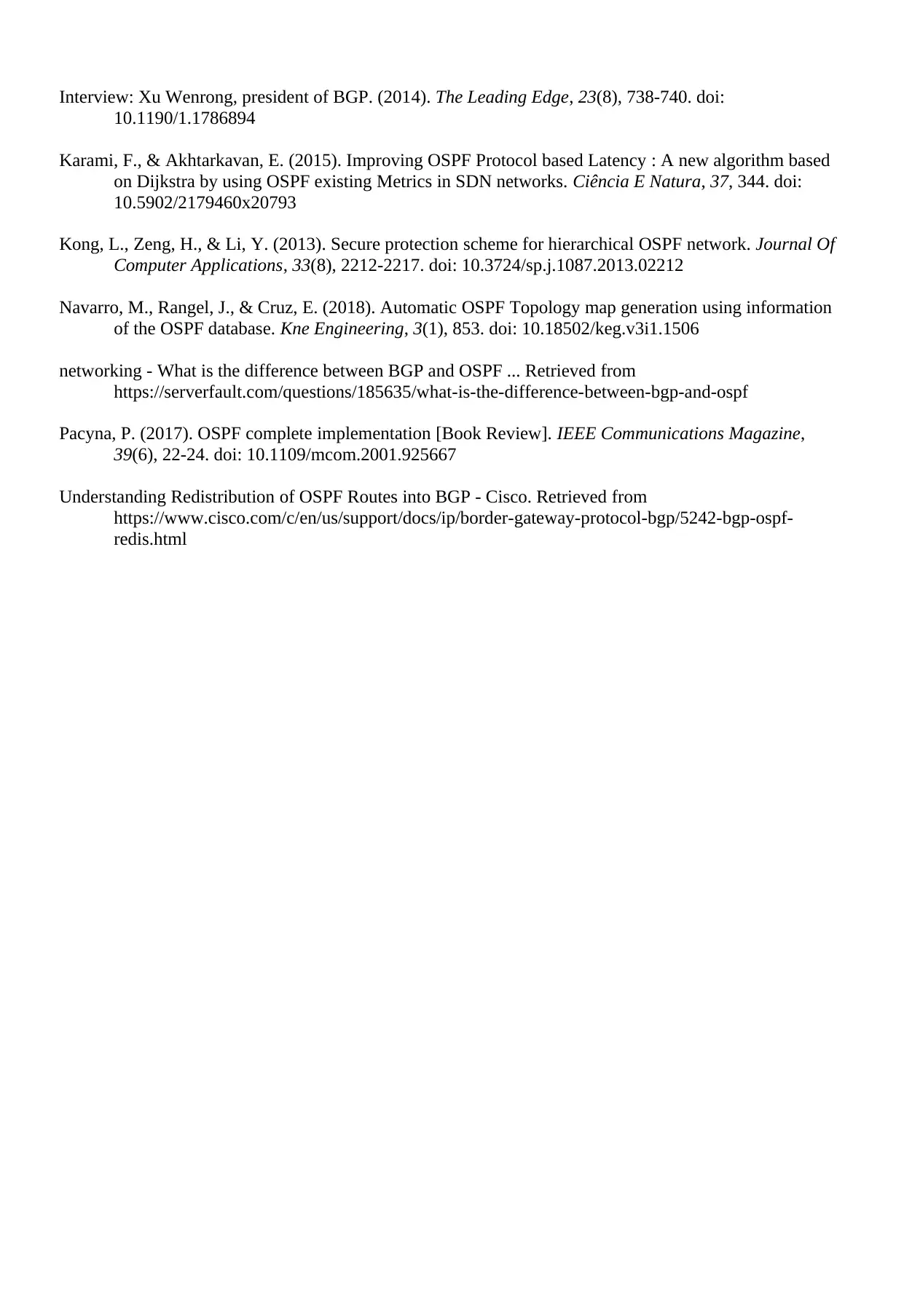
Interview: Xu Wenrong, president of BGP. (2014). The Leading Edge, 23(8), 738-740. doi:
10.1190/1.1786894
Karami, F., & Akhtarkavan, E. (2015). Improving OSPF Protocol based Latency : A new algorithm based
on Dijkstra by using OSPF existing Metrics in SDN networks. Ciência E Natura, 37, 344. doi:
10.5902/2179460x20793
Kong, L., Zeng, H., & Li, Y. (2013). Secure protection scheme for hierarchical OSPF network. Journal Of
Computer Applications, 33(8), 2212-2217. doi: 10.3724/sp.j.1087.2013.02212
Navarro, M., Rangel, J., & Cruz, E. (2018). Automatic OSPF Topology map generation using information
of the OSPF database. Kne Engineering, 3(1), 853. doi: 10.18502/keg.v3i1.1506
networking - What is the difference between BGP and OSPF ... Retrieved from
https://serverfault.com/questions/185635/what-is-the-difference-between-bgp-and-ospf
Pacyna, P. (2017). OSPF complete implementation [Book Review]. IEEE Communications Magazine,
39(6), 22-24. doi: 10.1109/mcom.2001.925667
Understanding Redistribution of OSPF Routes into BGP - Cisco. Retrieved from
https://www.cisco.com/c/en/us/support/docs/ip/border-gateway-protocol-bgp/5242-bgp-ospf-
redis.html
10.1190/1.1786894
Karami, F., & Akhtarkavan, E. (2015). Improving OSPF Protocol based Latency : A new algorithm based
on Dijkstra by using OSPF existing Metrics in SDN networks. Ciência E Natura, 37, 344. doi:
10.5902/2179460x20793
Kong, L., Zeng, H., & Li, Y. (2013). Secure protection scheme for hierarchical OSPF network. Journal Of
Computer Applications, 33(8), 2212-2217. doi: 10.3724/sp.j.1087.2013.02212
Navarro, M., Rangel, J., & Cruz, E. (2018). Automatic OSPF Topology map generation using information
of the OSPF database. Kne Engineering, 3(1), 853. doi: 10.18502/keg.v3i1.1506
networking - What is the difference between BGP and OSPF ... Retrieved from
https://serverfault.com/questions/185635/what-is-the-difference-between-bgp-and-ospf
Pacyna, P. (2017). OSPF complete implementation [Book Review]. IEEE Communications Magazine,
39(6), 22-24. doi: 10.1109/mcom.2001.925667
Understanding Redistribution of OSPF Routes into BGP - Cisco. Retrieved from
https://www.cisco.com/c/en/us/support/docs/ip/border-gateway-protocol-bgp/5242-bgp-ospf-
redis.html
1 out of 8
Related Documents
Your All-in-One AI-Powered Toolkit for Academic Success.
+13062052269
info@desklib.com
Available 24*7 on WhatsApp / Email
![[object Object]](/_next/static/media/star-bottom.7253800d.svg)
Unlock your academic potential
Copyright © 2020–2025 A2Z Services. All Rights Reserved. Developed and managed by ZUCOL.




